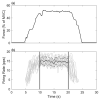Characteristics of the Electrophysiological Properties of Neuromuscular Motor Units and Its Adaptive Strategy Response in Lower Extremity Muscles for Seniors with Pre-Sarcopenia: A Preliminary Study
- PMID: 33809692
- PMCID: PMC8002219
- DOI: 10.3390/ijerph18063063
Characteristics of the Electrophysiological Properties of Neuromuscular Motor Units and Its Adaptive Strategy Response in Lower Extremity Muscles for Seniors with Pre-Sarcopenia: A Preliminary Study
Abstract
Older adults with sarcopenia, which is an aging-related phenomenon of muscle mass loss, usually suffer from decreases in both strength and functional performance. However, the causality between function loss and physiological changes is unclear. This study aimed to explore the motor unit characteristics of the neurological factors between normal subjects and those with sarcopenia. Five risk-sarcopenia (age: 66.20 ± 4.44), five healthy (age: 69.00 ± 2.35), and twelve young (age: 21.33 ± 1.15) participants were selected. Each participant performed knee extension exercises at a 50% level of maximal voluntary isometric contraction. Next, electromyogram (EMG) signals were collected, and information on each parameter-e.g., motor unit number, recruitment threshold, the slope of the mean firing rate to recruitment threshold, y-intercept, firing rate per unit force, and mean motor unit firing rate (MFR)-was extracted to analyze muscle fiber discrimination (MFD). Meanwhile, force variance was used to observe the stability between two muscle groups. The results suggested that there was no difference between the three groups for motor unit number, recruitment threshold, y-intercept, mean firing rate, and motor unit discrimination (p > 0.05). However, the slope of MFR and firing rate per unit force in the risk-sarcopenia group were significantly higher than in the young group (p < 0.05). Regarding muscle performance, the force variance in the non-sarcopenia group was significantly higher than the young group (p < 0.05), while the risk-sarcopenia group showed a higher trend than the young group. This study demonstrated some neuromuscular characters between sarcopenia and healthy elderly and young people when performing the same level of leg exercise tasks. This difference may provide some hints for discovering aging-related strength and function loss. Future studies should consider combining the in vivo measurement of muscle fiber type to clarify whether this EMG difference is related to the loss of muscle strength or mass before recruiting symptomatic elderly participants for further investigation.
Keywords: Decomposed Electromyography; aging; motor unit; sarcopenia.
Conflict of interest statement
The authors declare no conflict of interest.
Figures



Similar articles
-
Age-related changes in motor unit firing pattern of vastus lateralis muscle during low-moderate contraction.Age (Dordr). 2016 Jun;38(3):48. doi: 10.1007/s11357-016-9915-0. Epub 2016 Apr 15. Age (Dordr). 2016. PMID: 27084115 Free PMC article.
-
Vastus Lateralis Motor Unit Recruitment Thresholds Are Compressed towards Lower Forces in Older Men.J Frailty Aging. 2020;9(4):191-196. doi: 10.14283/jfa.2020.19. J Frailty Aging. 2020. PMID: 32996555
-
Motor unit control properties in constant-force isometric contractions.J Neurophysiol. 1996 Sep;76(3):1503-16. doi: 10.1152/jn.1996.76.3.1503. J Neurophysiol. 1996. PMID: 8890270 Clinical Trial.
-
The role of novel motor unit magnetic resonance imaging to investigate motor unit activity in ageing skeletal muscle.J Cachexia Sarcopenia Muscle. 2021 Feb;12(1):17-29. doi: 10.1002/jcsm.12655. Epub 2020 Dec 22. J Cachexia Sarcopenia Muscle. 2021. PMID: 33354940 Free PMC article. Review.
-
Does the frequency content of the surface mechanomyographic signal reflect motor unit firing rates? A brief review.J Electromyogr Kinesiol. 2007 Feb;17(1):1-13. doi: 10.1016/j.jelekin.2005.12.002. Epub 2006 Feb 23. J Electromyogr Kinesiol. 2007. PMID: 16497517 Review.
Cited by
-
Exploration of a machine learning approach for diagnosing sarcopenia among Chinese community-dwelling older adults using sEMG-based data.J Neuroeng Rehabil. 2024 May 9;21(1):69. doi: 10.1186/s12984-024-01369-y. J Neuroeng Rehabil. 2024. PMID: 38725065 Free PMC article.
-
Vascular Impairment, Muscle Atrophy, and Cognitive Decline: Critical Age-Related Conditions.Biomedicines. 2024 Sep 13;12(9):2096. doi: 10.3390/biomedicines12092096. Biomedicines. 2024. PMID: 39335609 Free PMC article. Review.
-
Relative Contributions of Motor Unit Firing Pattern, Muscle Quantity, and Muscle Quality to Maximum Muscle Strength in Female Patients with Early and Severe Knee Osteoarthritis.Ann Biomed Eng. 2025 Jul 17. doi: 10.1007/s10439-025-03802-2. Online ahead of print. Ann Biomed Eng. 2025. PMID: 40676418
-
Acetylcholine receptor-β inhibition by interleukin-6 in skeletal muscles contributes to modulating neuromuscular junction during aging.Mol Med. 2024 Oct 10;30(1):171. doi: 10.1186/s10020-024-00943-3. Mol Med. 2024. PMID: 39390392 Free PMC article.
-
Multi-channel EMG manifestations of upper-extremity muscle coordination imbalance among community-dwelling sarcopenic seniors.Biomed Eng Online. 2024 Nov 18;23(1):115. doi: 10.1186/s12938-024-01310-3. Biomed Eng Online. 2024. PMID: 39551737 Free PMC article.
References
-
- United Nations, Department of Economic and Social Affairs, Population Division . World Population Ageing. United Nations; New York, NY, USA: 2017.
Publication types
MeSH terms
LinkOut - more resources
Full Text Sources
Other Literature Sources

